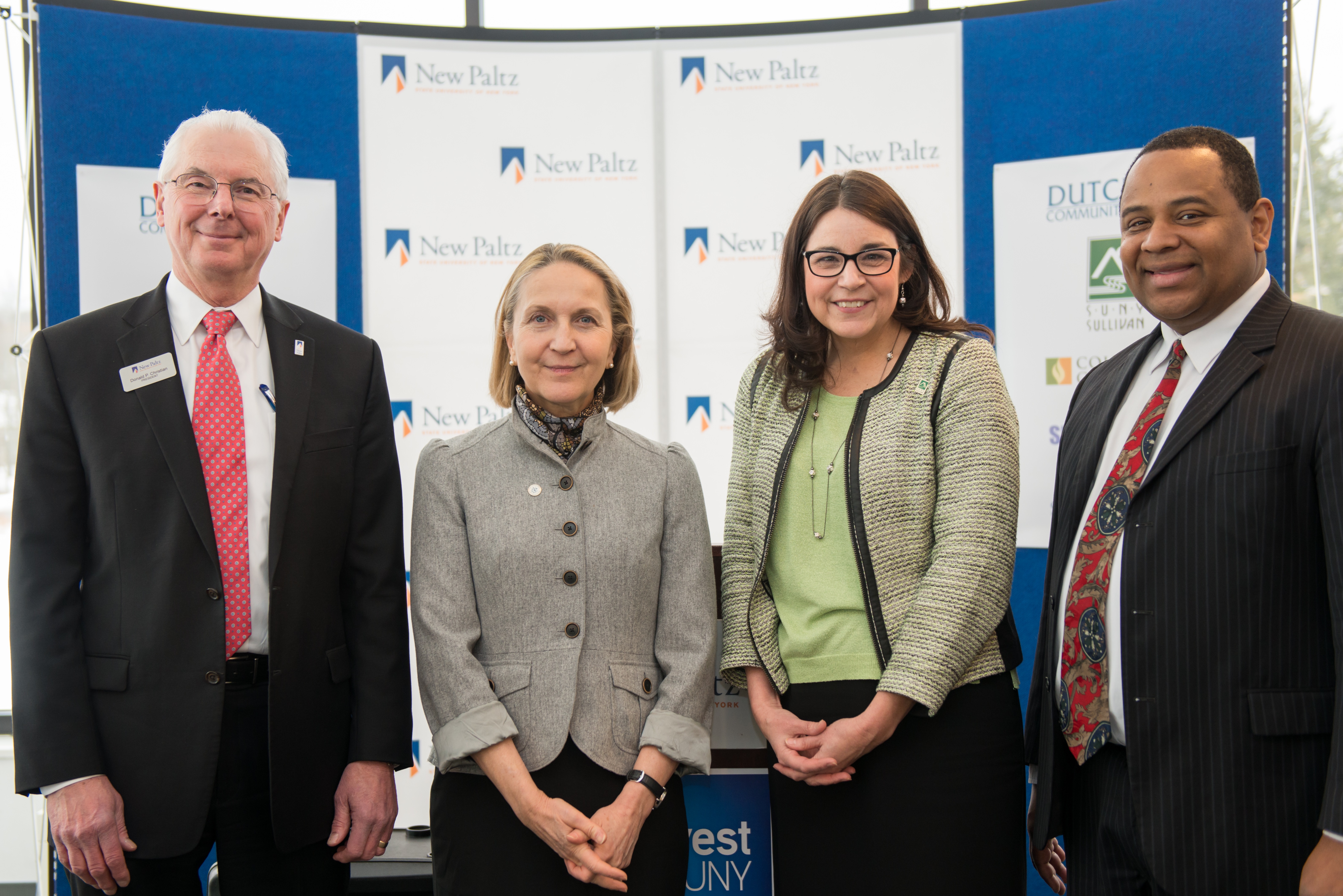SUNY leaders call on legislators for continued bold leadership, support for local colleges
Investment Fund would support completion goal of 150,000 SUNY graduates annually
The leadership from several State University of New York (SUNY) campuses in the Mid-Hudson region today called on local legislative leaders to continue their bold leadership in supporting New York’s public higher education sector by creating a new Investment Fund and extending NYSUNY 2020 – including the broadly successful rational tuition policy – in the 2015-16 New York State Budget.
On the SUNY New Paltz campus, SUNY New Paltz President Donald P. Christian, Dutchess Community College President Pamela R. Edington, SUNY Sullivan President Karin Hilgersom, as well as Joseph Watson, Columbia-Greene Community College’s vice president and dean of students and enrollment management, were joined by senior-level administrators to present a unified voice advocating for all 64 of SUNY’s campuses.
“The rational tuition policy has allowed SUNY New Paltz to hire new professors, expand course offerings, and increase student financial aid by more than $2 million, helping keep student loan debt of New Paltz graduates below the national average, and making a high-quality public education possible for some students who otherwise could not afford it,” said Christian. “Continuing this critical policy and increasing state support through a new investment fund will make it possible for comprehensive colleges, like New Paltz, to expand our positive impact on student success and the continued economic resurgence in New York State. We look forward to the legislature’s support for these crucial initiatives.”
Donald Katt, president of SUNY Ulster, said, “The SUNY Board of Trustees has recommended to the State Legislature a rational base aid plan for the SUNY community colleges. For the State to come closer to funding one-third of the operating budgets of the community colleges, the SUNY Board recommendation is suggesting a $250 increase in base aid, per year, for five years. It is our sincere hope that the two Houses of the State Legislature can agree to implement this recommendation.”
Pamela R. Edington, president of Dutchess Community College, said, “Sustaining sufficient and predictable funding for one of the State’s most important resources – its public higher education system – will remove many of the financial uncertainties faced by students and institutions. For Dutchess Community College, state and county support are vital to our ability to provide a quality, affordable education that prepares students for transfer or careers. We know these students are more likely to remain in New York state, and there are few investments made by government that have such a high rate of return.”
William Richards, president of SUNY Orange, said, “Chancellor Zimpher has a plan for SUNY to produce one-third more graduates annually by 2020. If we are to realize the Chancellor’s vision for a stronger, more robust SUNY, we must convince the leadership in Albany to commit the funding necessary so that SUNY can expand access to programs statewide and streamline services to fully support our students. New York State has not held up its end of the bargain with regard to funding for community colleges, and thus we’ve all been required to do more … with less. Unfortunately, it is our students who are bearing the brunt of that financial burden. I urge our friends in Albany to invest in SUNY, as the Chancellor has requested, and I also ask that they develop a rational funding plan for our community colleges. A $250 increase per FTE for each of the next three years will be a bold step toward beginning to tip our funding scales back into balance.”
Karin Hilgersom, president of SUNY Sullivan, said, “I applaud the Chancellor’s efforts to increase base aid to community colleges by $250 per year for the next three years. As community colleges, we provide open access and even second chances to residents of all ages and backgrounds. We provide transfer education, small class sizes with caring faculty, and workforce training. The goal is to increase access and completion in order to achieve a well-educated New York State. The State must increase its investment in community colleges so that we can sustain our important work.”
James Campion, president of Columbia-Greene Community College, said, “The Invest in SUNY campaign is truly visionary and will provide a meaningful path to completion, as it offers opportunities to all New Yorkers. This is a key time for colleges in the SUNY system to strengthen programming through an extension of the rational tuition initiative established by NYSUNY 2020.”
Since NYSUNY 2020 was first enacted, SUNY campuses have used additional revenue generated by rational tuition to grow and expand student services, including the hiring of 520 net new instructional staff, 270 of who are full-time faculty, and the implementation of 100 new degree programs reflecting high-demand areas in New York’s workforce. Additionally, SUNY continues to be a huge economic driver for the state, serving 3 million New Yorkers every year – including students, faculty and staff, and more – and an economic powerhouse that generates $21 billion annually for New York.
The key component of SUNY’s budget request is an Investment Fund that will enable SUNY to graduate 150,000 students annually by 2020 through the system-wide scale up of evidence-based programs known to support student success, including Finish in Four completion promises, applied learning, Educational Opportunity Programs (EOP), and expanded advisement services. SUNY Chancellor Nancy Zimpher outlined this objective in her recent State of the University Address.
“We cannot plan the future of our State University on yesterday’s dollars, which is why extending this legislation until 2020 is essential. NYSUNY 2020 is perhaps the smartest, most impactful legislation to support SUNY in history,” said Chancellor Zimpher. “Governor Cuomo and state leaders showed excellent foresight when this bill was enacted, positioning our campuses to drive regional economic development for New York while protecting our students’ investment, taking tuition roulette off the table so that they are able to plan for the full cost of college without the possibility of unexpected tuition spikes.”

